Rainbow Sharks, also know as Ruby Sharks. Despite their name, aren’t true sharks. They area actually part of the carp family.
These freshwater fish require specific care, in well-maintained aquariums with plenty of hiding spots.
Compatibility with other fish and a good size tank is a key consideration; they’re territorial and do best with species that won’t provoke their aggression. Understanding their dietary needs, habitat requirements, and social behaviours is crucial for creating a healthy stress free environment.
In the upcoming section, I will break down exactly what you need to provide the perfect habitat, care needs, diet and ideal tank mates.
Rainbow Shark Facts & Overview
| Rainbow Shark Fact | Details |
| Scientific Name: | Epalzeorhynchos frenatum |
| Care Level: | Moderate |
| Native Region: | Southeast Asia |
| Lifespan: | 5–8 years, up to 10 years in optimal conditions |
| Size: | Up to 6 inches (approximately 15 cm) |
| Family: | Cyprinidae |
| Diet: | Omnivore |
| Minimum Tank Size: | 200+ litres (55 gallons) |
| Compatibility: | Compatible with a variety of active, similarly-sized species |
Origin
Rainbow Sharks originate from Southeast Asia in rivers and lakes. They play a key role in their ecosystems, often navigating complex environments.
Adapting them to aquarium life requires understanding their natural habitats as they will need plenty of room with lots of plants a décor to navigate around.
This background is crucial for anyone looking to keep Rainbow Sharks, providing a foundation for creating a suitable home for these unique creatures.
Appearance and Behaviour of Rainbow Sharks
General Appearance
- Body: These fish possess a streamlined, elongated body, similar to that of a shark, with a dark, often black, body that may sometimes exhibit a greenish hue.
- Fins: The bright red or ruby fins, including the caudal, dorsal, pectoral, and anal fins, provide a contrast to their dark body, becoming their most distinguishing feature.
- Other Features: They have a pointed snout and a pair of barbels near their mouth, which assist them in scavenging food from the bottom of their habitat.
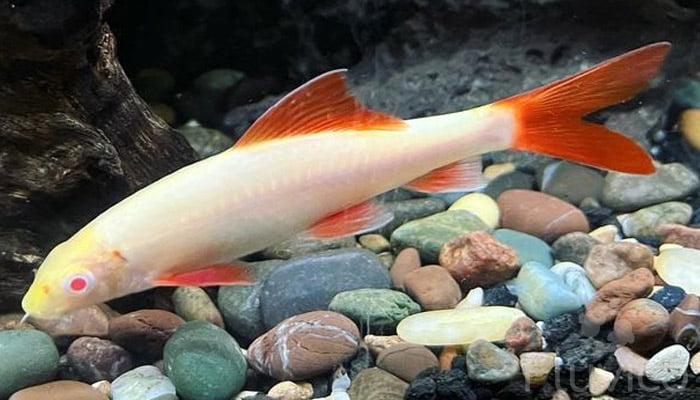
The Albino Rainbow Shark
The Albino Rainbow Shark sometimes called albino ruby shark, is a variant of the standard Rainbow Shark. Just as its name suggests, this variant exhibits albinism, which is a condition characterised by a lack of pigmentation.
The Albino Rainbow Shark has a pale, pinkish-white body but they still posses the red fins.
They can seem more chilled and laid back than the regular variety but this could be due to them sometimes having poor eye site, making it hard to spot other fish to bully.
They are cared for in the same way as the standard rainbow shark
Rainbow Shark Male or Female
Mature males tend to be slimmer and slightly smaller than females. The black line running along the edges of the male’s anal fin is often more intense than that of the female. Additionally, females may have a more rounded abdomen, especially during breeding season. However, these differences are subtle and may not be apparent in all individuals.
General Behaviour and Temperament
Typical Behaviour Rainbow Sharks are known for their active, bottom-dwelling nature. They are often seen swimming along the bottom of their tanks, exploring their surroundings and searching for food. They also enjoy having plenty of hiding spaces like caves or dense plantations, where they retreat when they feel threatened or stressed. Moreover, they are also nocturnal, meaning they’re more active during the night and prefer to rest or hide during the day. Do no be alarmed if you see them swimming upside down, this is normal behaviour. They skim the surface water like this or the underside of leaves.
Are Rainbow Sharks Aggressive? They are considered a semi-aggressive fish. Especially towards their own kind and other bottom-dwelling fish, particularly in a confined space. This is due to their territorial nature. They often claim a certain part of the aquarium as their own and guard it against intruders.
This territoriality can lead to chasing or nipping, especially if the tank is too small or lacks enough hiding spaces. Therefore, they are not recommended for small or crowded aquariums or with timid or slow-moving species that can’t evade their advances.
Rainbow Shark Lifespan & Size
- Rainbow Shark Size: Rainbow Sharks generally reach an adult size of about 6 inches (15 cm).
- Lifespan: On average, they can live between 5 and 8 years. However, in optimal conditions, they can live up to 10 years or more.
Habitat and Tank Requirements
Rainbow Shark Tank Size
As a guideline, the minimum tank size for a single shark should be 200+ litres or 55 gallons. This size allows enough room for the fish to move freely, reducing territorial disputes and stress.
However, if you’re planning to introduce other fish into the aquarium, particularly other bottom-dwelling species, you should consider a larger tank. For each additional Rainbow Shark or similar sized fish, add an extra 40 gallons to the tank size. This will ensure all fish have adequate territory and reduce the chance of aggressive behaviour.
Rainbow Shark Water Parameters
Maintaining the correct water parameters is crucial for the health and wellbeing of your Shark. Here are the ideal conditions you should aim for:
- Temperature: They thrive in tropical temperatures. The water temperature in the tank should be kept between 22°C to 26°C (72°F to 80°F).
- pH: They prefer slightly acidic to neutral water conditions. The ideal pH range is between 6.5 and 7.5.
- Hardness: It’s generally recommended to keep the water hardness between 5 and 15 dH.
- Water Cleanliness: Regular water changes are a must to maintain cleanliness. It’s crucial to keep the nitrate levels low, as high levels can cause stress and illness.
Please note that abrupt changes in these parameters can be very harmful to Rainbow Sharks, so changes should always be made gradually. 
Habitat and Requirements
- Substrate: They prefer fine gravel or sand as a substrate, which allows them to root around and forage for food as they would in their natural habitat.
- Lighting: Moderate lighting is ideal. Too bright lighting may cause stress.
- Filtration: Good filtration is necessary to maintain water quality. A powerful filter that can handle the bioload and create a moderate current is recommended, as they are used to flowing waters in their natural habitat.
- Heater: A reliable aquarium heater is essential to maintain the water temperature within the ideal range.
Décor and Ideal Plants
Decorations:
- Caves and Rocks: Caves made from rocks or aquarium-safe materials can provide them with a private space. You can create arches or small alcoves using rocks.
- Driftwood: Pieces of driftwood not only add a natural look to your tank but also serve as additional hiding spots.
Ideal Plants:
- Java Fern: This plant is hardy and easy to care for. Its wide leaves provide excellent cover
- Anubias: Another robust plant that can thrive in various conditions. Anubias has broad leaves, providing great hiding spots.
- Amazon Sword: With its tall, broad leaves, this plant offers excellent cover and contributes to a natural-looking aquarium.
- Cryptocoryne: Available in various species and sizes, these plants are perfect for creating a diverse and interesting landscape.
- Java Moss: This is a great plant for covering rocks and driftwood, creating additional hiding spots and enhancing the tank’s natural look.
When adding plants, ensure they are well-rooted or tied down, as Rainbow Sharks can dislodge poorly secured plants while exploring or foraging.
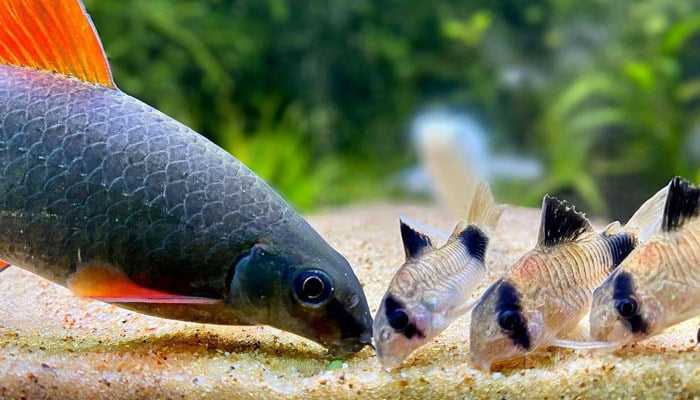
Rainbow Shark Care
Rainbow Shark Diet & Feeding
Rainbow Sharks are omnivores, meaning they eat both plant matter and animal-based foods. Here’s what their diet can include:
- Commercial Foods: High-quality pellets or flakes designed for omnivorous fish can make up the bulk of their diet. These usually contain a balanced blend of proteins, vegetables, vitamins, and minerals.
- Live or Frozen Foods: Supplement their diet with live or frozen foods like brine shrimp, daphnia, and bloodworms. These not only provide essential proteins but also stimulate the Rainbow Shark’s natural hunting instincts.
- Vegetables: Occasionally, offer blanched vegetables such as peas, spinach, or zucchini. These can contribute beneficial fibres and nutrients to their diet.
- Algae and Plant Matter: They also graze on algae and soft plant matter in the tank, which can contribute to their intake of vegetable matter.
Remember to feed them in small quantities 1-2 times a day, offering only as much food as they can consume in a few minutes. Overfeeding can lead to health issues and pollute the tank. Maintain a varied diet to ensure they receive all the necessary nutrients.
Health and Diseases
Rainbow Sharks, like all fish, are prone to certain health issues and diseases such as Ich, swim Bladder disease, fin rot, parasites and infections. However, providing excellent care and maintaining a clean, stress-free environment can help mitigate many potential problems.
- Stress-Related Issues: Rainbow Sharks can suffer from Stress-Related Issues due to their nature and active lifestyle. For instance, if their environment is too small, lacks hiding spaces, or if they’re housed with incompatible tank mates, they can become stressed, which could lead to a weakened immune system and increased susceptibility to various diseases. The bigger the tank the better.
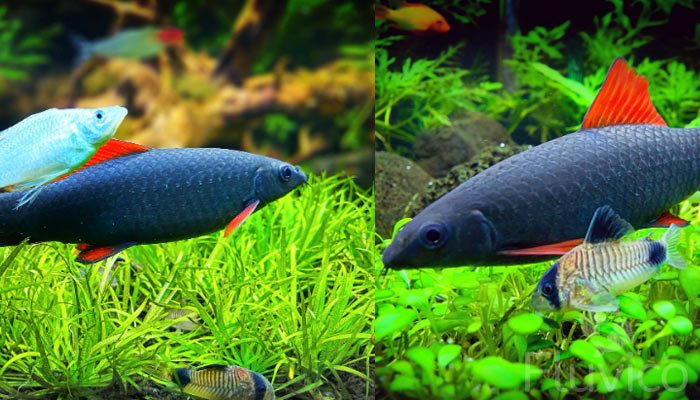
Rainbow Shark Tank Mates
Choosing suitable tank mates for Rainbow Sharks is essential due to them being semi-aggressive. They do best with species that match their size, activity level, and temperament. Here are some ideal tank mates:
- Danios: Fast, active species like Zebra Danios or Pearl Danios are good matches.
- Rainbow fish: Their similar size and active nature make them suitable companions.
- Gouramis: Larger Gouramis can hold their own, but avoid smaller or more timid species.
- Loaches: Species such as Clown Loaches or Yoyo Loaches, which also prefer bottom dwelling, can coexist with Rainbow Sharks.
- Angelfish: Larger Angelfish might be able to coexist with Rainbow Sharks, but their slow-moving and peaceful nature could make them targets.
- Cichlids: Some types of larger, more aggressive Cichlids may work, but smaller, less aggressive Cichlids could become targets.
Tank Mates to Avoid
Certain species are typically not suitable due to their size, temperament, or habitat preferences:
- Betta Fish, Goldfish, Guppies, Neon Tetras: These species are generally not recommended as they are slow-moving, peaceful, or small fish that may be bullied by the Rainbow Shark.
- Turtles, Crabs, Shrimp: These are generally not suitable tank mates. Turtles can be dangerous to fish, while crabs and shrimp may become a meal for the Rainbow Shark due to their small size and bottom-dwelling habits.
- Other Rainbow Sharks: Despite their beauty, housing multiple Rainbow Sharks together is typically not recommended due to their highly territorial nature. They may engage in continuous aggressive behaviour, leading to high stress levels and potential injury. If you wish to keep more than one Rainbow Shark, ensure the tank is exceptionally large with numerous hiding spots to delineate territories.
Remember, it’s generally advised to keep only one Rainbow Shark per tank, unless it’s particularly large with plenty of hiding spots. Always closely monitor any new additions for signs of aggression or distress.
Can you Breed Rainbow Sharks
Breeding Rainbow Sharks in a home aquarium is extremely difficult and is rarely successful. Unlike many other fish species, they do not have well-documented breeding habits and do not readily reproduce in captivity.
Most of the Sharks available in the pet trade are bred commercially on fish farms, often using hormonal methods to induce spawning. If you’re an amateur, it’s unlikely you’ll be able to breed these fish successfully. As such, breeding Rainbow Sharks should generally be left to professionals or highly experienced fish keepers.
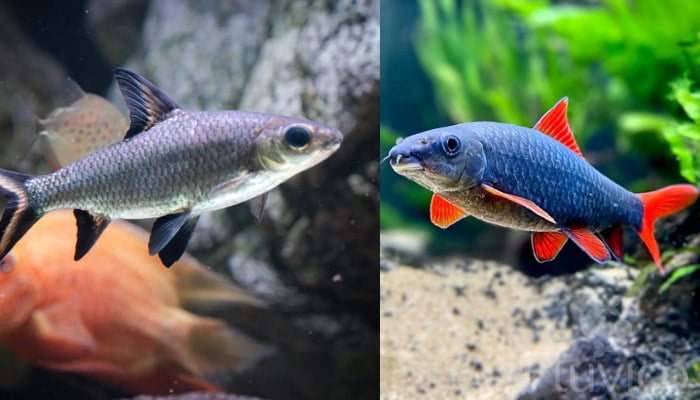
Inter-species Comparisons
Rainbow Shark vs Bala Shark and Red Tail Shark
- Bala Shark: Bala Sharks can grow much larger than Rainbow Sharks, up to 14 inches (35 cm) in length, and they require significantly larger tanks as a result. They have silver bodies with black margins on their fins. Bala Sharks are schooling fish and are generally more peaceful than Rainbow Sharks.
- Red Tail Shark: Red Tail Sharks have a similar body shape and size to Rainbow Sharks but are entirely black except for their vibrant red tail. They are also territoriality, and can be quite aggressive, especially in confined spaces.
It is not recommended to house any of these sharks together unless you have an exceptionally large tank with lots of plants and décor. Doing so can cause conflict and stress not just for your sharks but all other community fish.
Should You Get a Rainbow Shark for Your Aquarium?
The decision to get a Rainbow Shark for your aquarium comes with its own set of benefits and drawbacks.
Benefits:
- Visual Appeal: There’s nothing else like them. Everyone will be asking what fish is that in your tank.
- Active Swimmers: Their active nature and unique bottom-dwelling behaviour can be fascinating to observe.
- Hardy Species: They are relatively hardy once acclimated, making them resilient against changes in water parameters.
Drawbacks:
- Semi-aggressive: Their aggressive behaviour can cause stress and conflict, particularly in smaller tanks or with certain tank mates.
- Tank Size: They require a larger tank with plenty of hiding spaces.
- Special Care Requirements: They have specific care requirements, including a need for certain water parameters and a varied diet, which may pose a challenge for the inexperienced.
Before deciding to get a Rainbow Shark, make sure you’re well-equipped to meet their specific needs and can provide a compatible environment for them to thrive. 
FAQs
Do Rainbow Sharks bite?
Rainbow Sharks typically don’t bite humans. However, they have been known to nip at the fins of other fish, particularly when defending their territory or if housed with incompatible tank mates.
Are Rainbow Sharks real sharks?
No, Rainbow Sharks are not true sharks. They’re freshwater fish belonging to the Cyprinidae family. They get their “shark” name due to their dorsal fin and torpedo-shaped body that resembles marine sharks.
Can Rainbow Sharks live with Bala Sharks
While Rainbow Sharks and Bala Sharks can both be kept in a home aquarium, they have different needs and temperaments. Bala Sharks are schooling fish that grow much larger than Rainbow Sharks. Keeping them together can lead to conflict.
Why is my Rainbow Shark not eating?
A Rainbow Shark might stop eating due to stress, illness, or incorrect water parameters. Changes in their environment, aggressive tank mates, or a diet lacking variety could also lead to loss of appetite. Check your water conditions and observe your fish’s behaviour to identify potential issues.
Why is my Rainbow Shark swimming upside down?
If your Rainbow Shark is constantly swimming upside down, it might have swim bladder disease, which affects a fish’s buoyancy. This condition can be caused by various factors, including poor diet, sudden changes in water temperature, or bacterial infection. Consult a vet for appropriate treatment.
More Reading
- 15 Types of Cryptocoryne: Which is Best For Your Aquarium Setup?

- 16 Awesome Low Light Aquarium Plants (Mosses, Ferns & Stem Plants)

- 16 Fast Growing Freshwater Aquarium Plants

- 18 Types of Aquarium Moss: Photos, Care, Propagation & Growth Guide

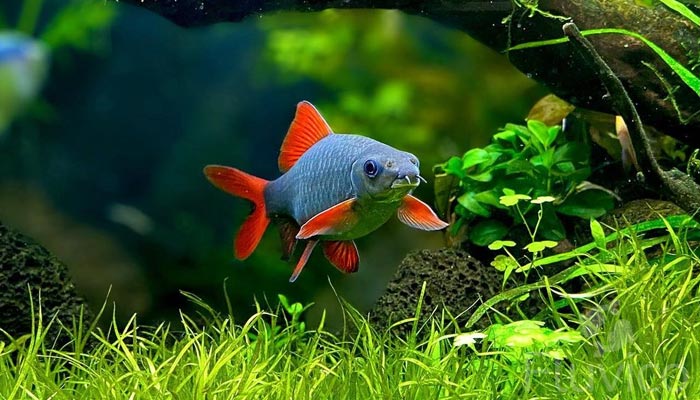
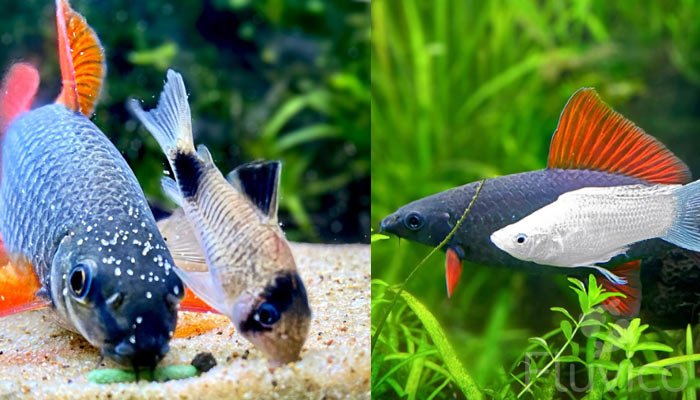

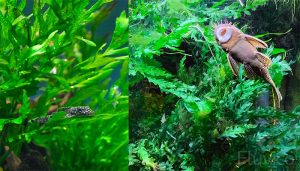


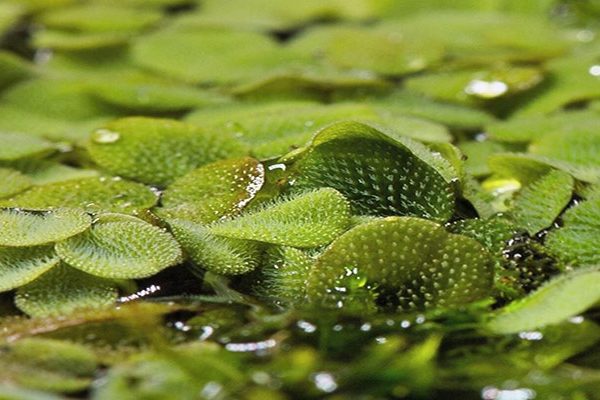
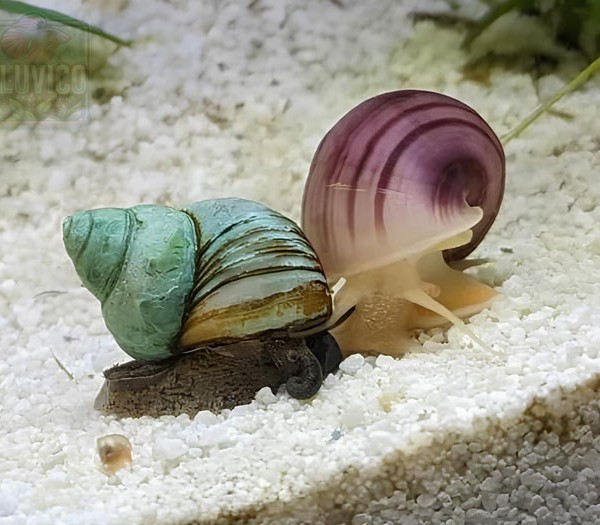
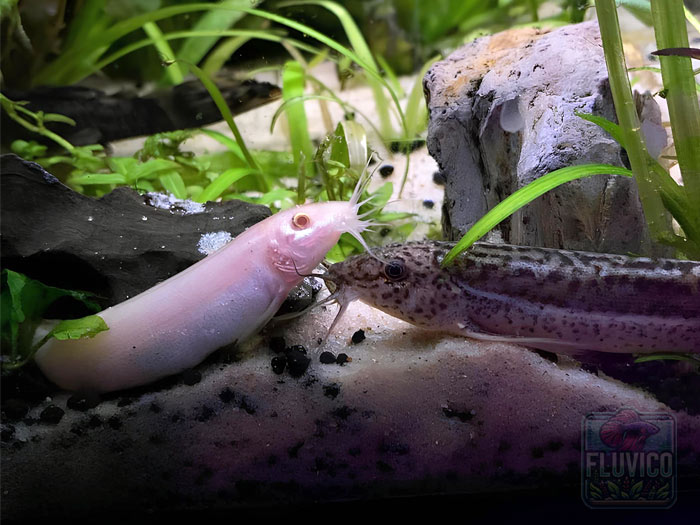
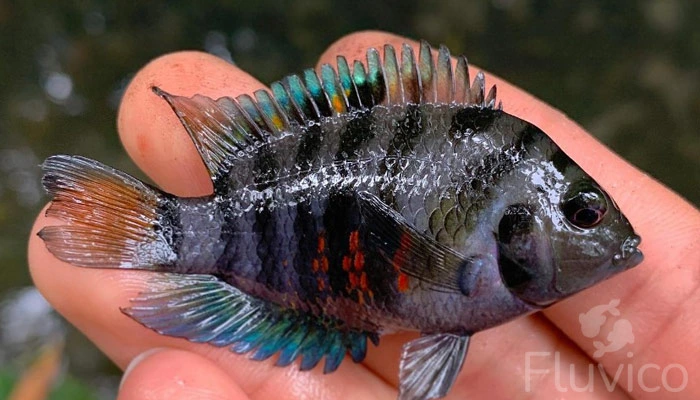

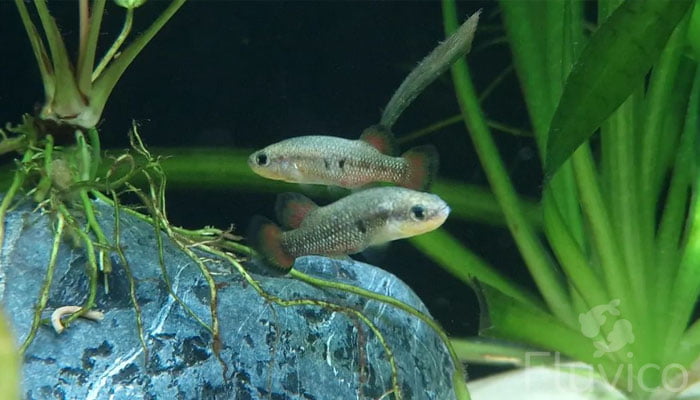
Hope you enjoyed our Rainbow Shark Care Guide!
If you have any questions? Ask away, we’re here to help!
All the best,
Daniel